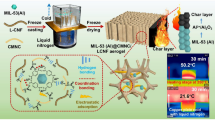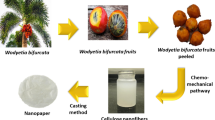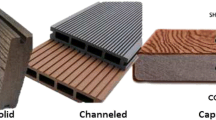Abstract
The sol–gel process was applied to enhance properties of pine sapwood. For this purpose wood prisms were soaked in nanoscaled precursor solutions prepared from titanium(IV) n-butoxide and titanium(IV) iso-propoxide, respectively, using vacuum impregnation technique. The wet composites were cured by special program with final heat treatment at 103 °C. Weight percent gains (WPG) of the wood specimen in the range of 19–25% were obtained due to these procedures. SEM investigations show that precursor solutions penetrate into the whole wood body and the titania formed after heat treatment in the composites is deposited in the pores (lumen) and partly in the cell walls of the wooden matrix. The moisture sorption was investigated in long term tests for a period of some months by storage at 20–23 °C in humid air (relative humidity of 99%) and ambient atmosphere (relative humidity 40–60%), respectively. For untreated reference samples the moisture sorption results in increasing of mass and volume according to saturation values of 24 and 13%, respectively, after about 15 days. The incorporation of titania reduces the saturation values of the moisture sorption by up to 12% in mass and by up to 5% in volume at a relative humidity of 99%. Thus, an enhancement of the dimensional stability of about 60% is obtained at best. The results demonstrate that modification of wood with sol–gel derived precursors can enhance its dimensional stability, which prevents the formation of cracks. Because of that reduced moisture sorption biological attacks should be delimited. Additionally, thermal analyses show a retarded combustion of the wood matrix due to titania infiltration.





Similar content being viewed by others
References
Ogiso K, Saka S (1993) Wood-inorganic composites prepared by sol-gel process II. Effects of ultrasonic treatments on preparation of wood-inorganic composites. Mokuzai Gakkaishi 39:301–307
Saka S, Tanno F (1996) Wood-inorganic composites prepared by the sol-gel process VI. Effects of a property-enhancer on fire-resistance in SiO2–P2O5 and SiO2–B2O3 wood-inorganic composites. Mokuzai Gakkaishi 42:81–86
Saka S, Ueno T (1997) Several SiO2 wood-inorganic composites and their fire-resisting properties. Wood Sci Technol 31:457–466
Saka S, Miyafuiji H, Tanno F (2001) Wood-inorganic composites prepared by the sol-gel process. J Sol-Gel Sci Technol 20:213–217
Miyafuji H, Saka S, Yamamoto A (1998) Holzforschung: 410-416
Mai C, Militz H (2004) Modification of wood with silicon compounds. Wood Sci Technol 37:339–348 (see also 453–461)
Mahltig B, Swaboda C, Roessler A, Böttcher H (2008) Functionalising wood by nanosol application. J Mater Chem 18:3180–3192
Mandala A, Tshabalala M, Sung L-P (2007) Wood surface modification by in situ sol-gel deposition of hybrid inorganic-organic thin films. J Coat Technol Res 4:483–490
Saka S, Sasaki M, Tanahashi M (1992) Wood-inorganic composites prepared by sol-gel processing I. Wood-inorganic composites with porous structure. Mokuzai Gakkaishi 38:1043–1049
Bücker M, Böcker W, Reinsch S, Unger B (2003) Wood modification by sol-gel derived precursors. Proceedings of the 1st European conference on wood modification, Ghent/Belgium, pp 255–259; ISBN 9080656526
Donath S, Militz H, Mai C (2004) Wood modification with alkoxysilanes. Wood Sci Technol 38:555–566
Saka S, Yakake Y (1993) Wood-inorganic composites prepared by sol–gel process III. Chemically-modified wood-inorganic composites. Mokuzai Gakkaishi 39:308–314
Miyafuji H, Saka S (1997) Fire-resisting properties in several TiO2 wood-inorganic composites and their topochemistry. Wood Sci Technol 31:449–455
Wagenführ R (1999) Anatomie des Holzes. DRW-Verlag. ISBN 3-87181-351-6, p 109
Acknowledgments
We are grateful to Nadine Hoffmann and Karin Keil for technical support.
Author information
Authors and Affiliations
Corresponding author
Rights and permissions
About this article
Cite this article
Hübert, T., Unger, B. & Bücker, M. Sol–gel derived TiO2 wood composites. J Sol-Gel Sci Technol 53, 384–389 (2010). https://doi.org/10.1007/s10971-009-2107-y
Received:
Accepted:
Published:
Issue Date:
DOI: https://doi.org/10.1007/s10971-009-2107-y




